
In Greek mythology, Astraeus or Astraios is an astrological deity. Some also associate him with the winds, as he is the father of the four Anemoi, by his wife, Eos.

The Caspian plover is a wader in the plover family of birds. The specific asiaticus is Latin and means "Asian", although in binomials it usually means the type locality was India.

The black-necked stork is a tall long-necked wading bird in the stork family. It is a resident species across the Indian Subcontinent and Southeast Asia with a disjunct population in Australia. It lives in wetland habitats and near fields of certain crops such as rice and wheat where it forages for a wide range of animal prey. Adult birds of both sexes have a heavy bill and are patterned in white and irridescent blacks, but the sexes differ in the colour of the iris with females sporting yellow irises and males having dark-coloured irises. In Australia, it is known as a jabiru although that name refers to a stork species found in the Americas. It is one of the few storks that are strongly territorial when feeding and breeding.

The Indian nightjar is a small nightjar which is a resident breeder in open lands across South Asia and Southeast Asia. Like most nightjars it is crepuscular and is best detected from its characteristic calls at dawn and dusk that have been likened to a stone skipping on a frozen lake - a series of clicks that become shorter and more rapid. They are sometimes spotted on roads when their eyes gleam red in the spotlight of a vehicle. There is considerable plumage variation across its range and can be hard to differentiate from other nightjars in the region especially in the field.

Ranunculus asiaticus, the Persian buttercup, is a species of buttercup (Ranunculus) native to the eastern Mediterranean region, southwestern Asia, southeastern Europe, and northeastern Africa.
Iceland Express was a low-fare airline headquartered in Reykjavík, Iceland that was acquired by WOW air. It operated services to several destinations in Europe using wet-leased aircraft. Its main base was Keflavík International Airport.

The Trachypachidae are a family of beetles that generally resemble small ground beetles, but that are distinguished by the large coxae of their rearmost legs. There are only six known extant species in the family, with four species of Trachypachus found in northern Eurasia and northern North America, and two species of Systolosoma in Chile and Argentina. They were much more diverse in the past, with dozens of described species from the Mesozoic.

Astraeus Limited, trading as Astraeus Airlines, was a British airline based at Astraeus House in Crawley, West Sussex, England. Founded in 2002, and named after the Greek God of the dusk, it entered administration on 21 November 2011, ceasing operations the same day.

The blue-throated barbet is an Asian barbet native to the foothills of the Himalayas and Southeast Asia. It inhabits lowland and montane forests at elevations of 200–2,000 m (660–6,560 ft).

The Chinese high-fin banded shark is a popular freshwater aquarium fish that belongs to the family Catostomidae. It grows to about 1.35 m long and is unsuitable for most home aquariums.

Pharyngeal teeth are teeth in the pharyngeal arch of the throat of cyprinids, suckers, and a number of other fish species otherwise lacking teeth.

Astraeus hygrometricus, commonly known as the hygroscopic earthstar, the barometer earthstar, or the false earthstar, is a species of fungus in the family Diplocystaceae. Young specimens resemble a puffball when unopened. In maturity, the mushroom displays the characteristic earthstar shape that is a result of the outer layer of fruit body tissue splitting open in a star-like manner. The false earthstar is an ectomycorrhizal species that grows in association with various trees, especially in sandy soils. A. hygrometricus was previously thought to have a cosmopolitan distribution, though it is now thought to be restricted to Southern Europe, and Astraeus are common in temperate and tropical regions. Its common names refer to the fact that it is hygroscopic (water-absorbing) and can open up its rays to expose the spore sac in response to increased humidity, then close them up again in drier conditions. The rays have an irregularly cracked surface, while the spore case is pale brown and smooth with an irregular slit or tear at the top. The gleba is white initially, but turns brown and powdery when the spores mature. The spores are reddish-brown and roughly spherical with minute warts, measuring 7.5–11 micrometers in diameter.

Astraeus is a genus of fungi in the family Diplocystaceae. The genus, which has a cosmopolitan distribution, contains nine species of earthstar mushroom. They are distinguished by the outer layer of flesh (exoperidium) that at maturity splits open in a star-shape manner to reveal a round spore sac. Additionally, they have a strongly hygroscopic character—the rays will open when moist, but when hot and dry will close to protect the spore sac. Species of Astraeus grow on the ground in ectomycorrhizal associations with trees and shrubs. Despite their similar appearance to the Geastrum earthstars Astraeus is not closely related.

The Catostomidae are the suckers of the order Cypriniformes, with about 78 species in this family of freshwater fishes. The Catostomidae are almost exclusively native to North America. The only exceptions are Catostomus catostomus, found in both North America and Russia, and Myxocyprinus asiaticus found only in China. In the Ozarks they are a common food fish and a festival is held each year to celebrate them. The bigmouth buffalo, Ictiobus cyprinellus, can reach an age up to 127 years, making it the oldest known freshwater teleost by more than 50 years.
Astraeus is a genus of "jewel beetles" in the subfamily Polycestinae, containing the following species:
Astraeus odoratus is a species of false earthstar in the family Diplocystaceae. Described as a new species in 2004, it was originally found in the Thai highlands growing in sandy or laterite-rich soil in dry lowland dipterocarp forests. The species is found in Southeast Asia.
Astraeus koreanus is a species of false earthstar in the family Diplocystaceae. Described as a new species in 1976, it is found in Korea. The species was originally named as a variety koreanus of Astraeus hygrometricus in 1958.

Sclerodermatineae is a suborder of the fungal order Boletales. Circumscribed in 2002 by mycologists Manfred Binder and Andreas Bresinsky, it contains nine genera and about 80 species. The suborder contains a diverse assemblage fruit body morphologies, including boletes, gasteroid forms, earthstars, and puffballs. Most species are ectomycorrhizal, although the ecological role of some species is not known with certainty. The suborder is thought to have originated in the late Cretaceous (145–66 Ma) in Asia and North America, and the major genera diversified around the mid Cenozoic (66–0 Ma).

Astraeus morganii is a species of false earthstar in the family Diplocystaceae. The fungus is found in the central to southern United States, extending southwards to Mexico. It is closely related to Astraeus pteridis, but has smaller fruit bodies and larger spores. The specific epithet honors American botanist Andrew Price Morgan.

Astraeus sirindhorniae is a species of false earthstar in the family Diplocystaceae. A. sirindhorniae can be distinguished from close relatives A. odoratus, A. asiaticus and A. hygrometricus by differences in fruit body size, spore size, spore ornamentation, and peridium structure. The fungus was discovered in Phu Khieo Wildlife Sanctuary in northeastern Thailand, as part of a project to document the biodiversity of mycorrhizal fungi. The specific epithet sirindhorniae honors Princess Maha Chakri Sirindhorn on the occasion the 84th birthday of her father, King Bhumibol Adulyadej. Known only from north and northeastern Thailand, A. sirindhorniae is suspected to be ectomycorrhizal with members of the Dipterocarpaceae, although this has not yet been proven.
















